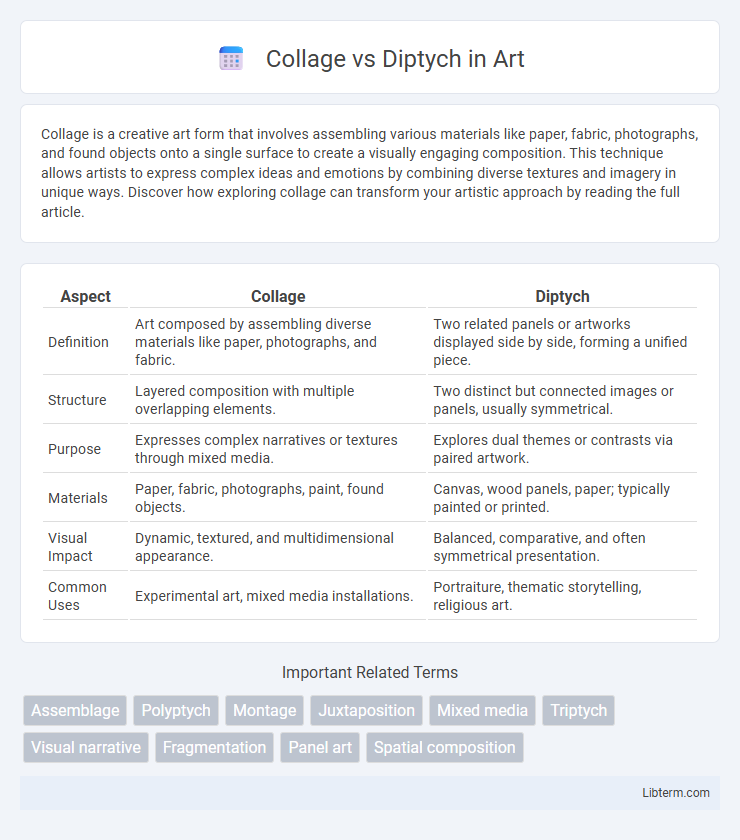Collage is a creative art form that involves assembling various materials like paper, fabric, photographs, and found objects onto a single surface to create a visually engaging composition. This technique allows artists to express complex ideas and emotions by combining diverse textures and imagery in unique ways. Discover how exploring collage can transform your artistic approach by reading the full article.
Table of Comparison
| Aspect | Collage | Diptych |
|---|---|---|
| Definition | Art composed by assembling diverse materials like paper, photographs, and fabric. | Two related panels or artworks displayed side by side, forming a unified piece. |
| Structure | Layered composition with multiple overlapping elements. | Two distinct but connected images or panels, usually symmetrical. |
| Purpose | Expresses complex narratives or textures through mixed media. | Explores dual themes or contrasts via paired artwork. |
| Materials | Paper, fabric, photographs, paint, found objects. | Canvas, wood panels, paper; typically painted or printed. |
| Visual Impact | Dynamic, textured, and multidimensional appearance. | Balanced, comparative, and often symmetrical presentation. |
| Common Uses | Experimental art, mixed media installations. | Portraiture, thematic storytelling, religious art. |
Introduction to Collage and Diptych
Collage combines various materials such as paper, fabric, and photographs onto a single surface to create a unified artwork, emphasizing texture and layered composition. A diptych consists of two related panels or canvases displayed together, often exploring contrasting or complementary themes within a single narrative framework. Understanding the distinct visual and conceptual approaches of collage and diptych enriches appreciation of contemporary mixed-media and paired artwork formats.
Defining Collage Art
Collage art is defined by the assembly of various materials such as paper, photographs, fabric, and other found objects onto a single surface to create a unified composition. Unlike a diptych, which consists of two separate panels often related visually or thematically, a collage integrates diverse elements into one cohesive artwork. This technique emphasizes texture, layering, and mixed media to convey complex visual narratives and abstract concepts.
Understanding the Diptych Format
The diptych format consists of two panels or images displayed side by side, creating a visual dialogue or contrast that emphasizes thematic or narrative connections. Unlike a collage, which assembles multiple fragments from various sources into a single composition, a diptych maintains clear separation between the two parts, enhancing comparison and complementarity. Understanding the diptych format allows artists and viewers to explore relationships between paired images through balance, juxtaposition, and continuity.
Historical Background of Collage
Collage traces its origins to early 20th-century avant-garde art movements, particularly Cubism, with Pablo Picasso and Georges Braque credited for pioneering the technique by incorporating newspaper clippings and fabric into paintings. The term "collage" derives from the French word "coller," meaning to glue, reflecting the method of assembling various materials onto a single surface. Unlike diptychs, which consist of two hinged panels often used in religious art since the Byzantine era, collage emphasizes fragmented, multi-material compositions that challenge traditional art forms.
Origins and Evolution of Diptych
Diptychs originated in the Roman Empire as hinged wooden tablets used for writing and painting, evolving into significant art pieces during the Byzantine period with religious iconography. Their form adapted through the Renaissance, serving as portable altarpieces or narrative sequences, reflecting shifts in spiritual and artistic practices. Contemporary diptychs extend beyond panels to photographic and digital art, highlighting continued evolution from classical origins to modern multimedia expressions.
Techniques Used in Collage Creation
Collage creation techniques involve assembling diverse materials such as paper, fabric, photographs, and found objects onto a single surface using adhesives, layering, cutting, and tearing to create textured, multidimensional compositions. Artists often employ mixed media methods, integrating paint, ink, and digital elements to enhance visual depth and thematic complexity. Unlike diptychs, which are defined by their two-paneled structure, collage emphasizes material juxtaposition and tactile interaction, allowing for more experimental and fragmented artistic expression.
Methods for Crafting a Diptych
Crafting a diptych involves creating two distinct yet thematically linked panels that together convey a unified narrative or concept, often using techniques such as painting, photography, or mixed media to establish visual dialogue. Unlike a collage, which layers diverse materials and elements onto a single surface for a composite effect, diptychs require careful composition and alignment to ensure coherence across the paired pieces. Artists frequently employ symmetry, color harmony, and complementary imagery to enhance the relational dynamic between the two panels, emphasizing contrast or continuity as foundational elements of the diptych method.
Artistic Purposes: Comparing Intentions
Collage emphasizes assembling diverse materials and images to create layered meanings, often exploring themes of fragmentation and juxtaposition. Diptych focuses on pairing two panels to establish a direct dialogue or contrast, frequently highlighting relationships or dualities within a unified composition. Both serve distinct artistic purposes by manipulating space and narrative to evoke complex viewer interpretations.
Visual Impact: Collage vs Diptych
Collages create a dynamic visual impact through their layered composition of diverse materials and images, offering complexity and texture that engage viewers on multiple sensory levels. Diptychs present two complementary or contrasting panels side-by-side, emphasizing balance and dialogue between the paired visuals to evoke a focused emotional response. The visual impact of a collage is often more chaotic and rich, while a diptych provides clarity and narrative tension through its structured duality.
Choosing Between Collage and Diptych
Choosing between collage and diptych depends on the intended artistic expression and narrative structure. Collage integrates diverse materials and images into a single, unified composition, suitable for exploring complex themes with layered meaning. Diptychs consist of two related panels, ideal for contrasting ideas or storytelling through paired visuals that engage viewers in a dialogic experience.
Collage Infographic

 libterm.com
libterm.com